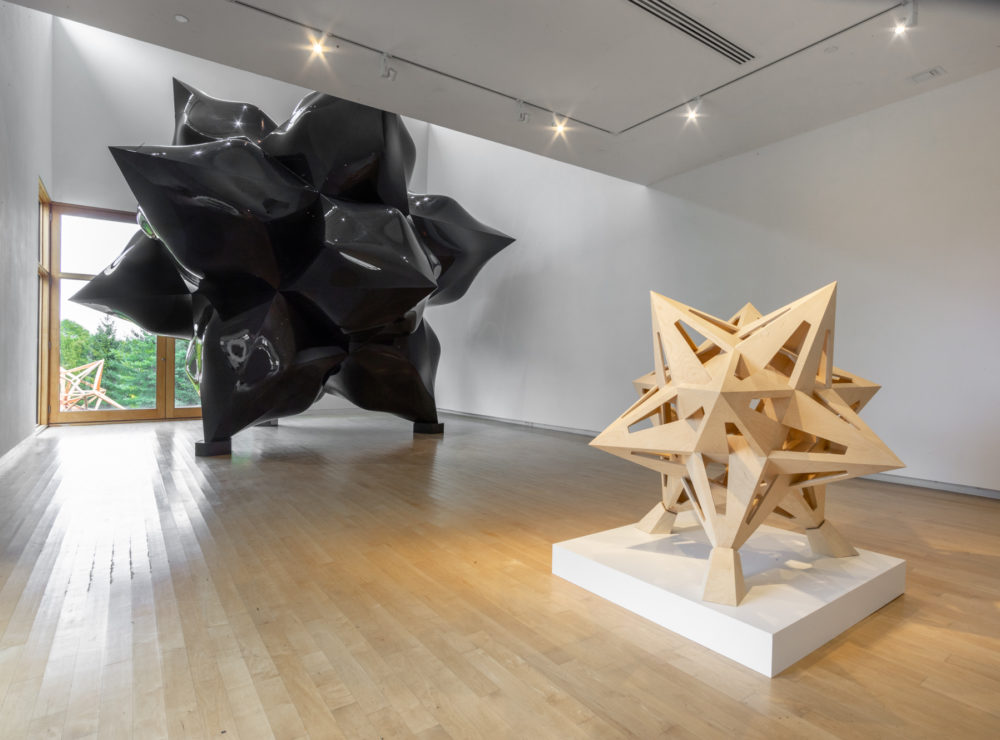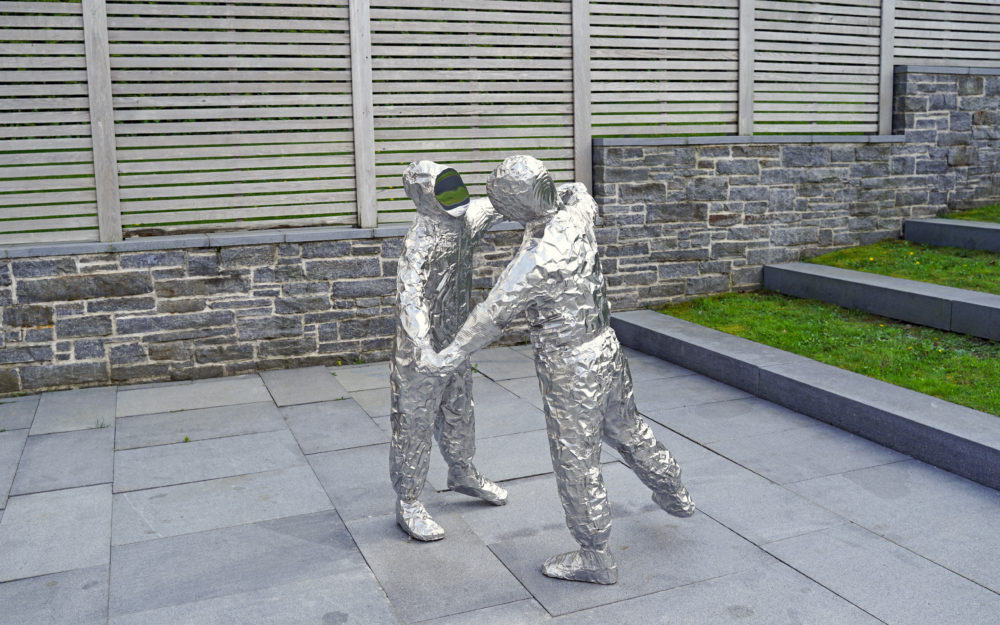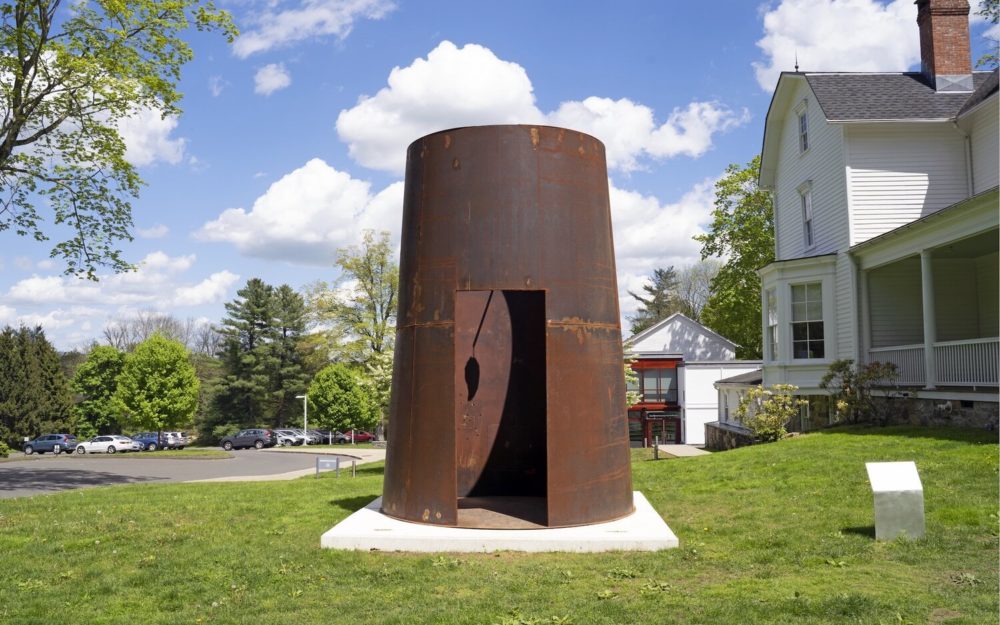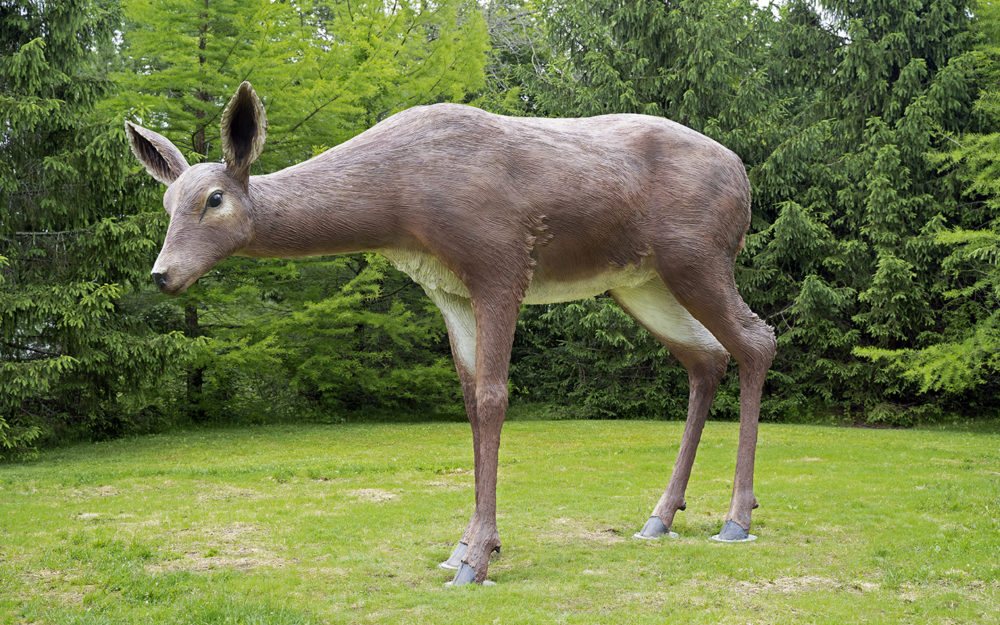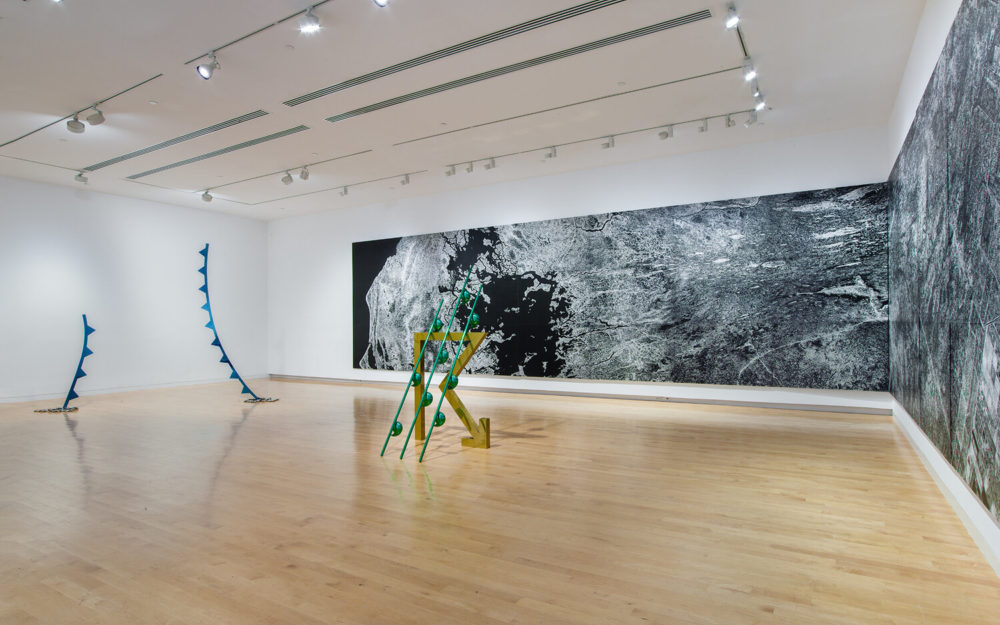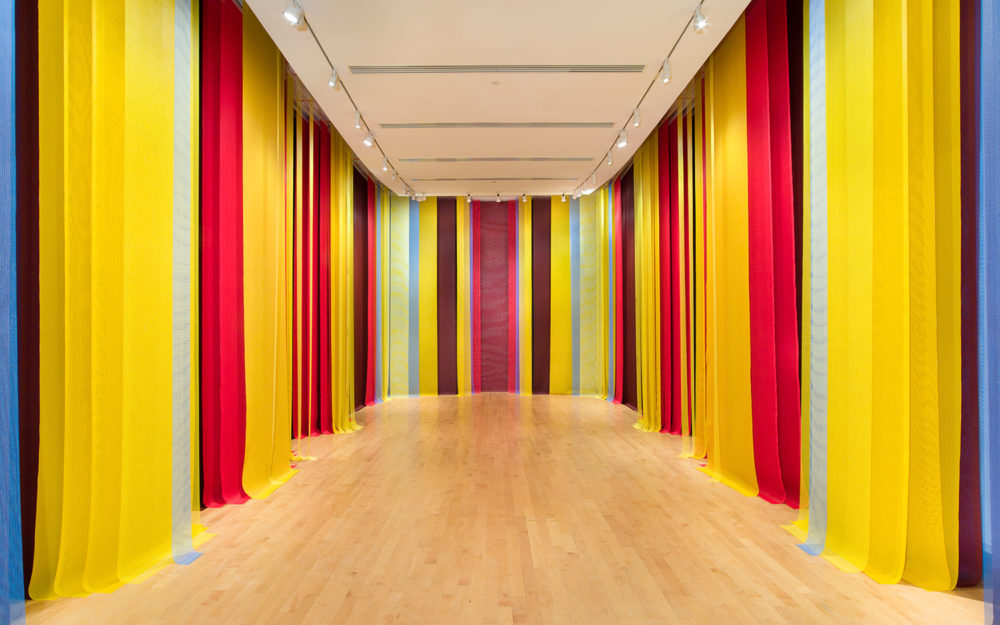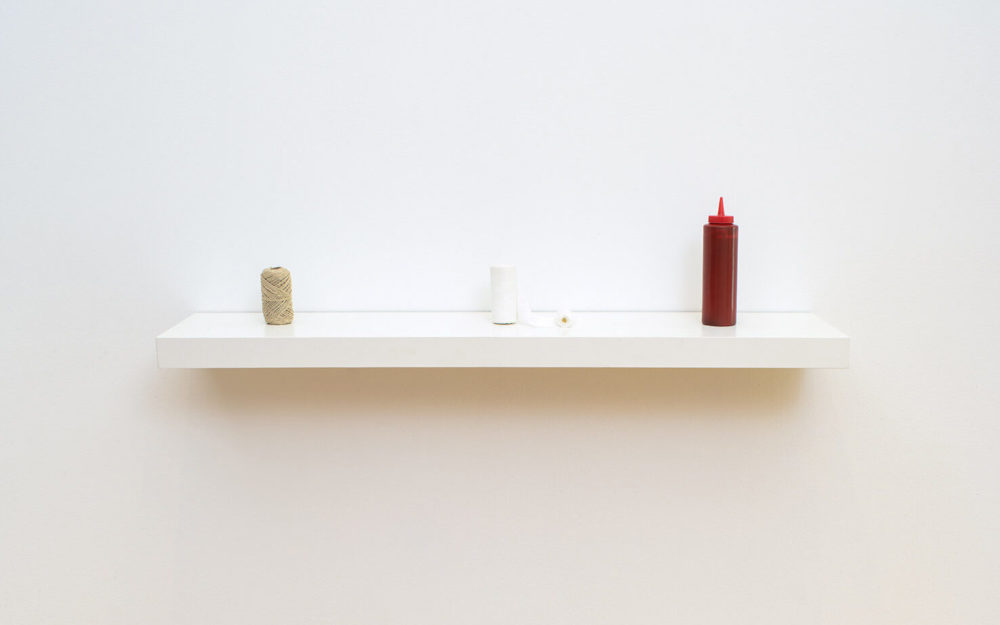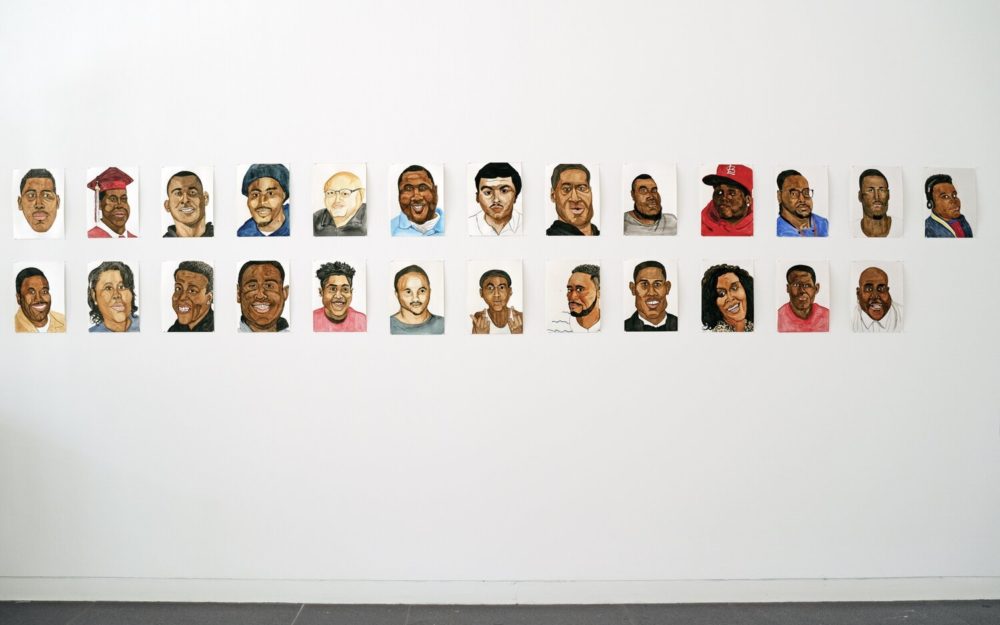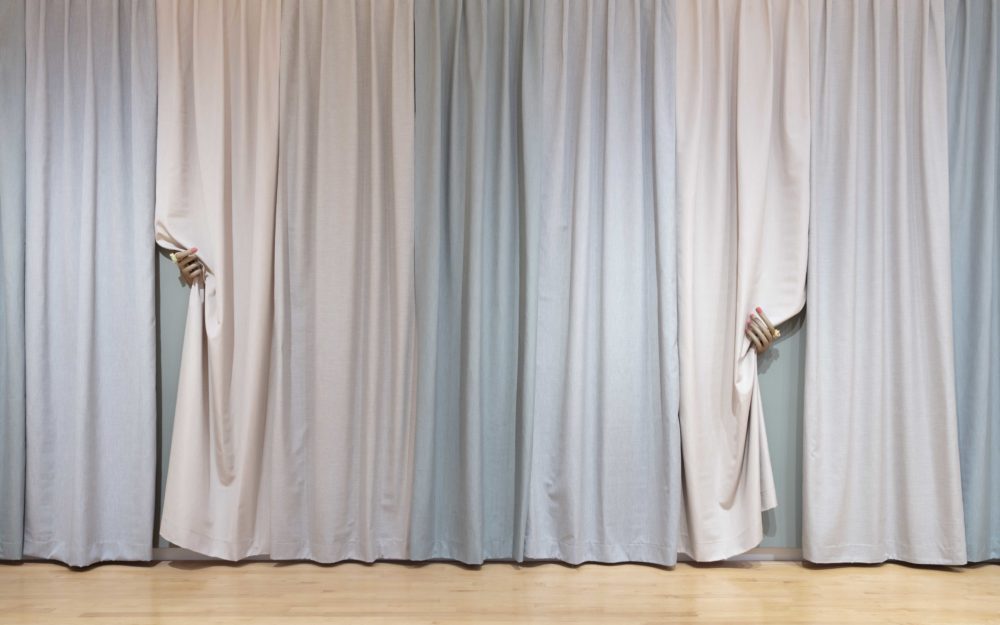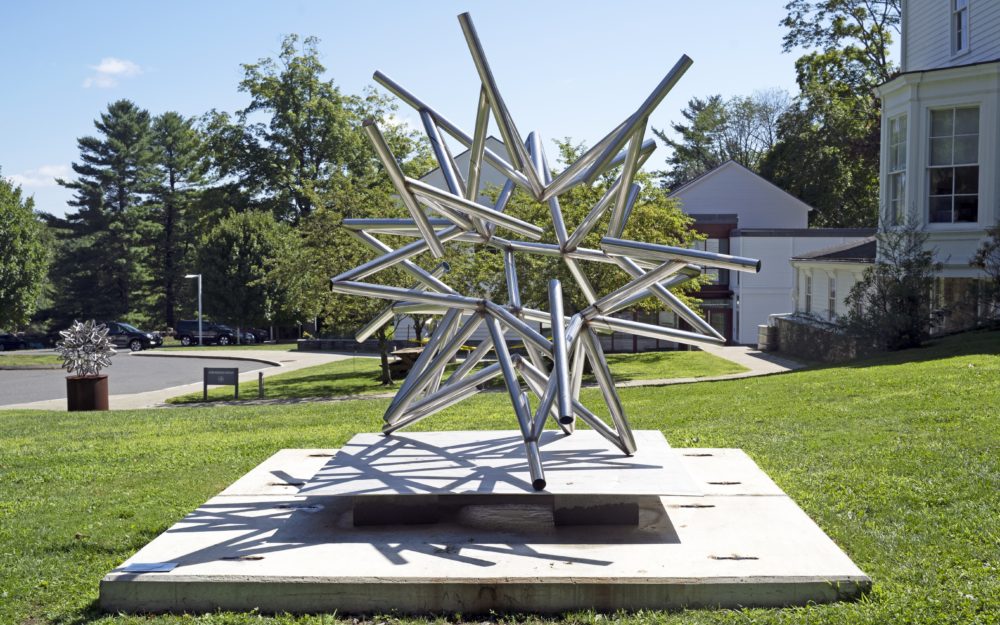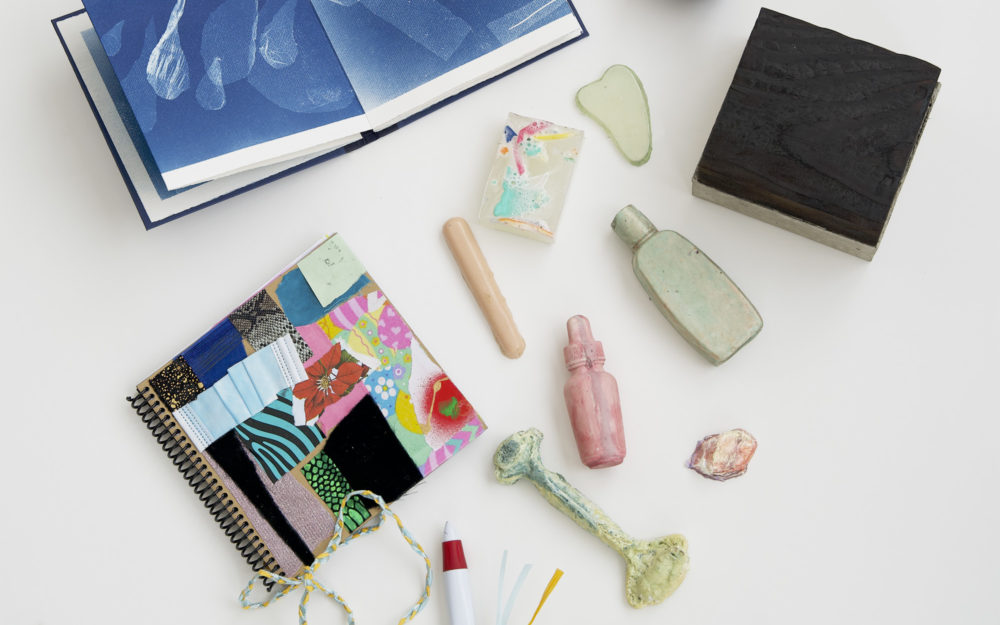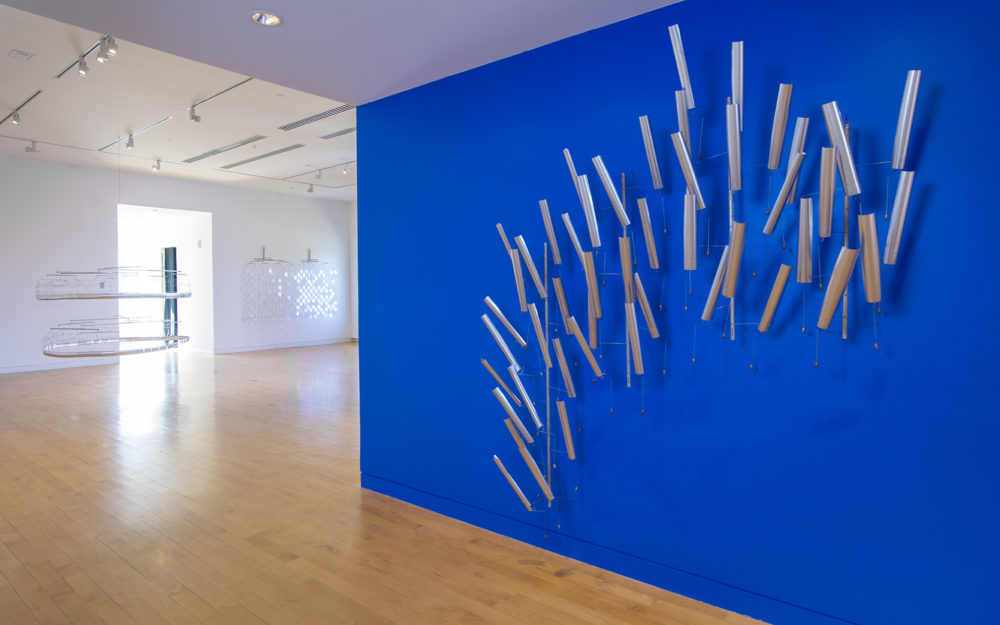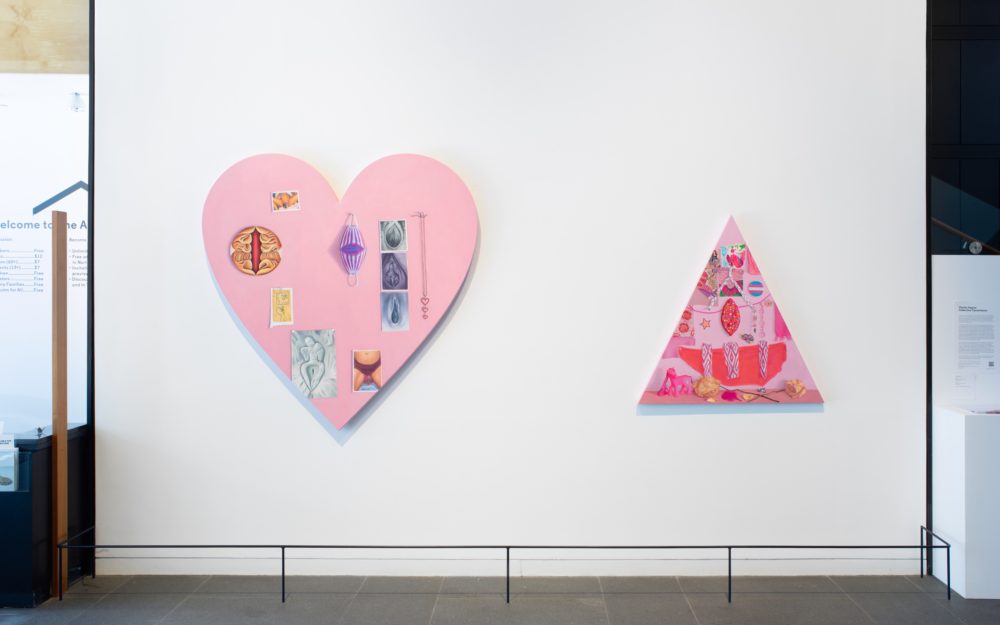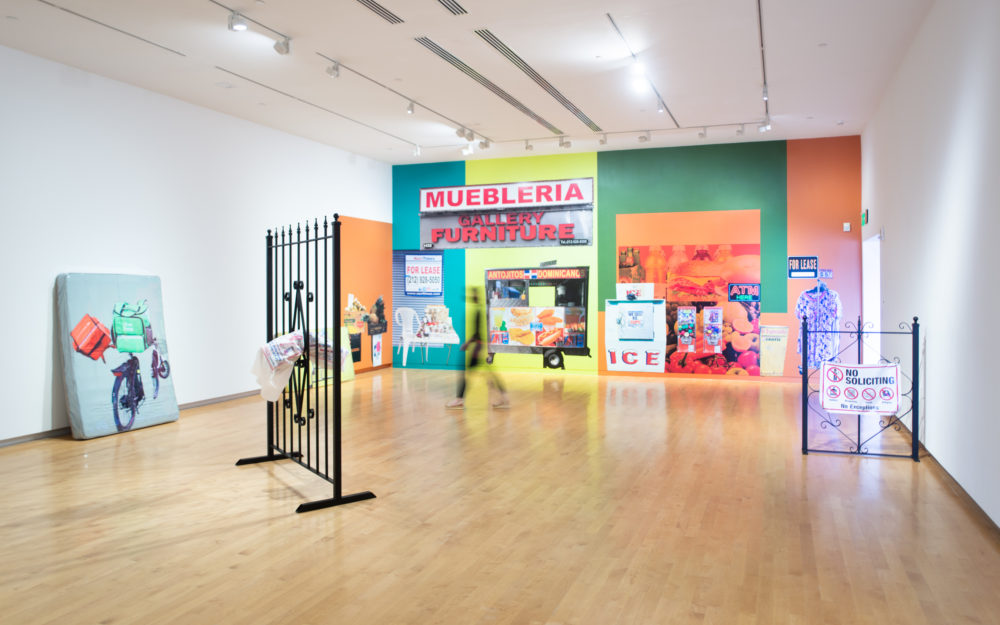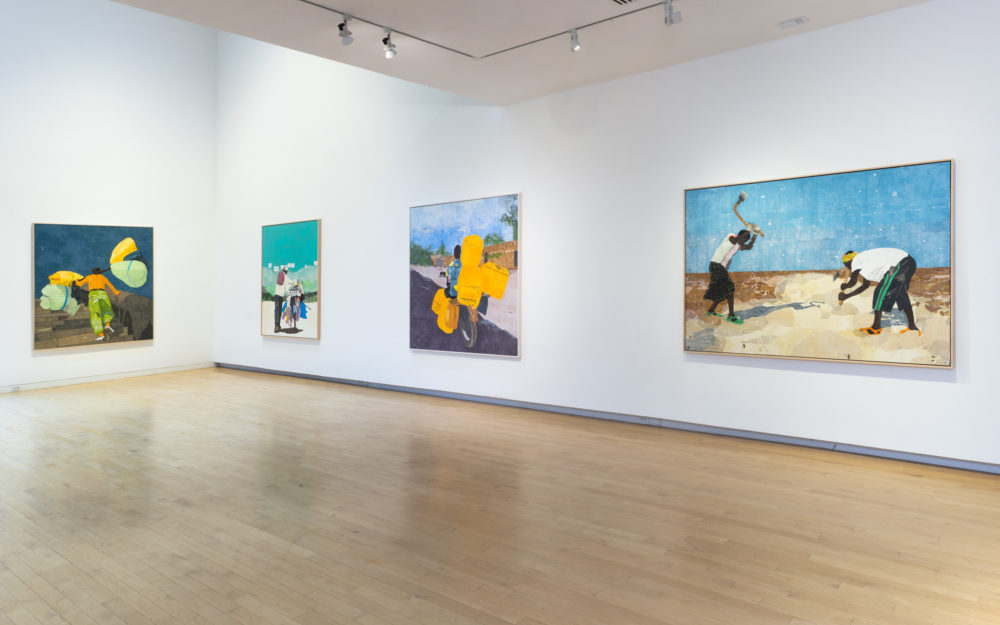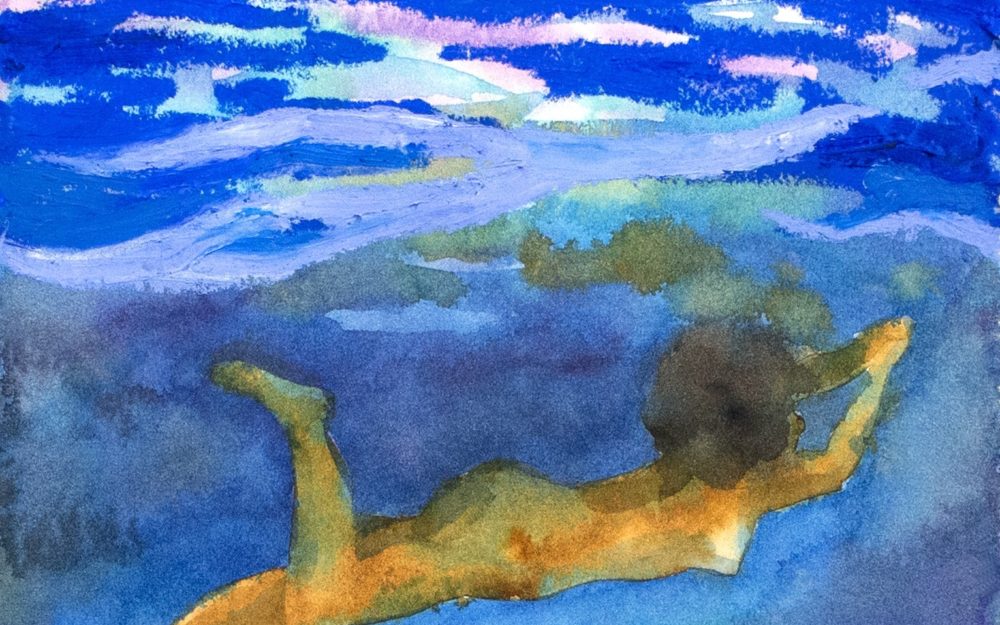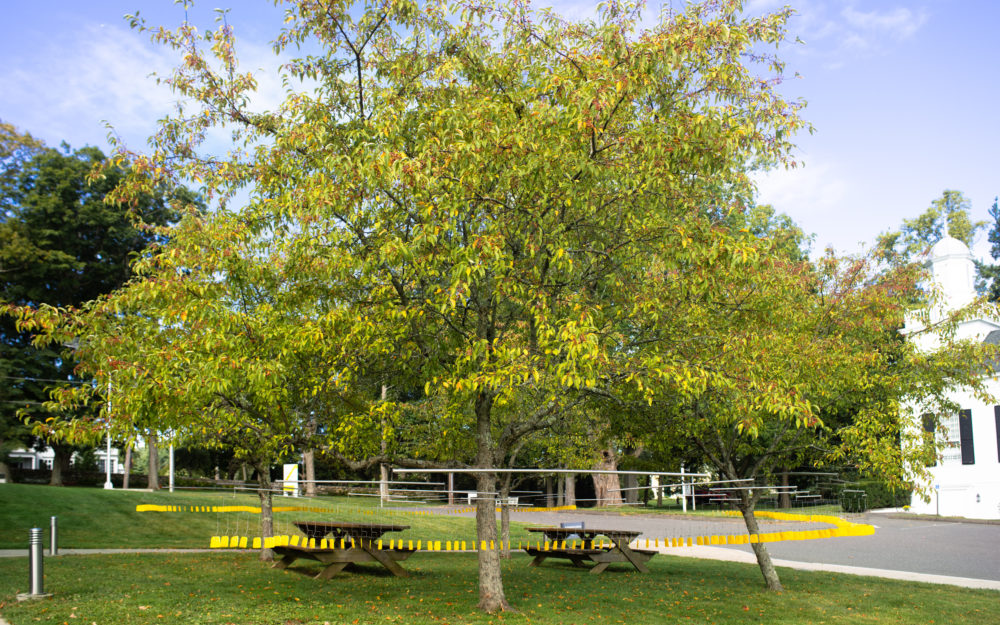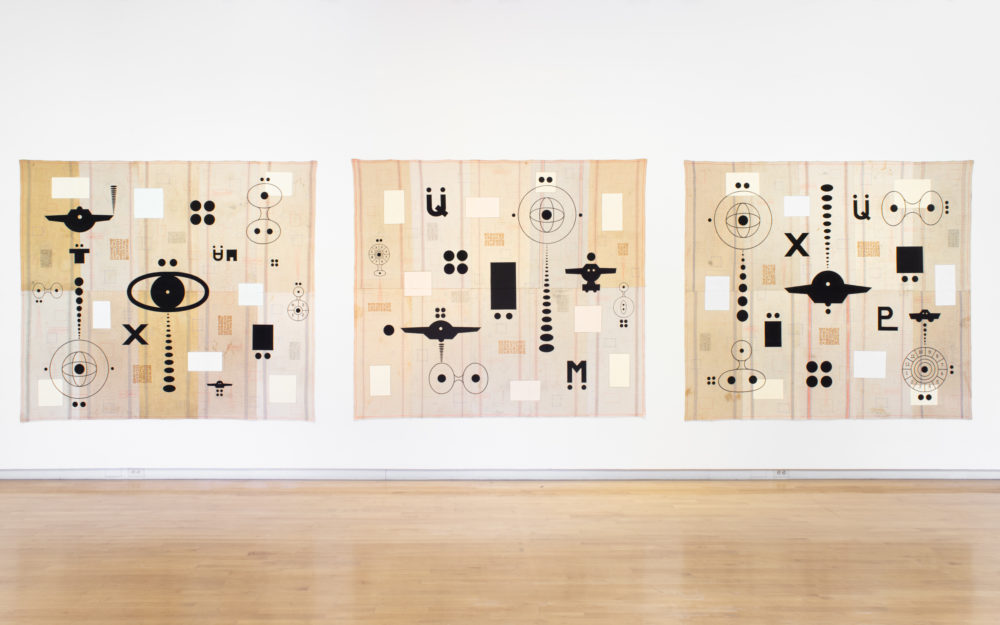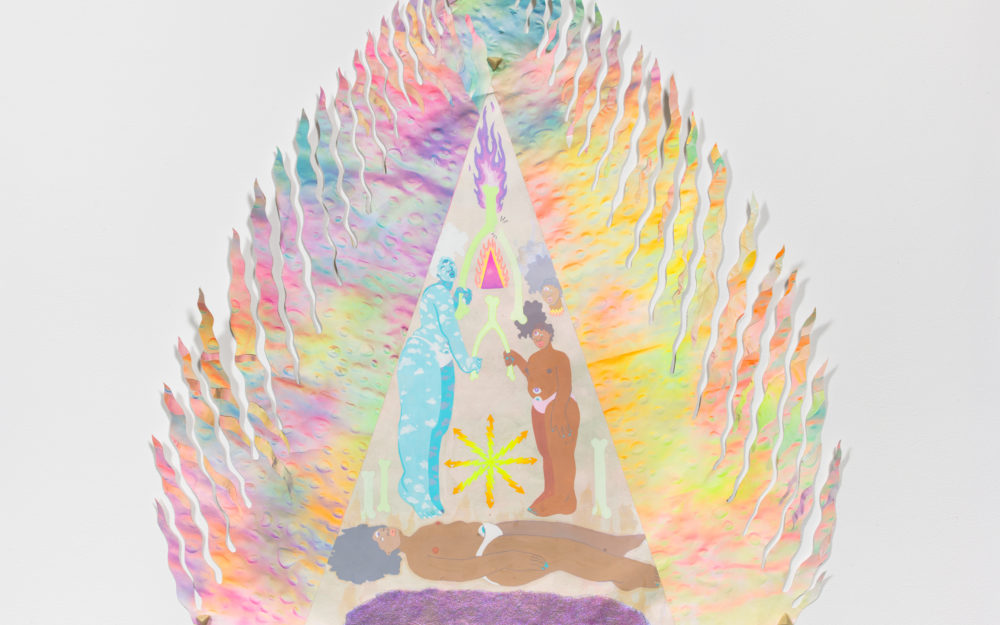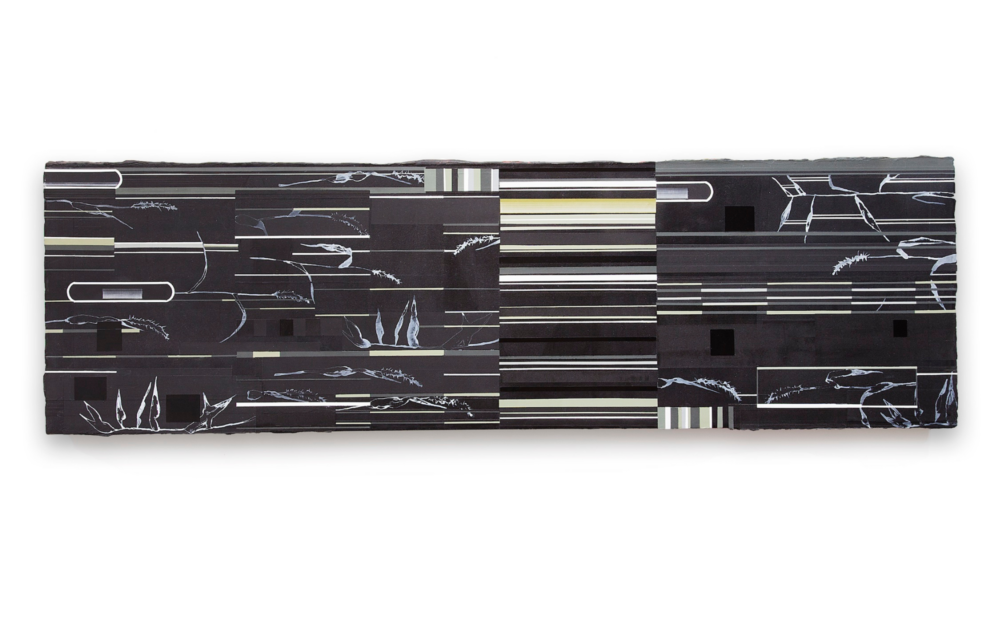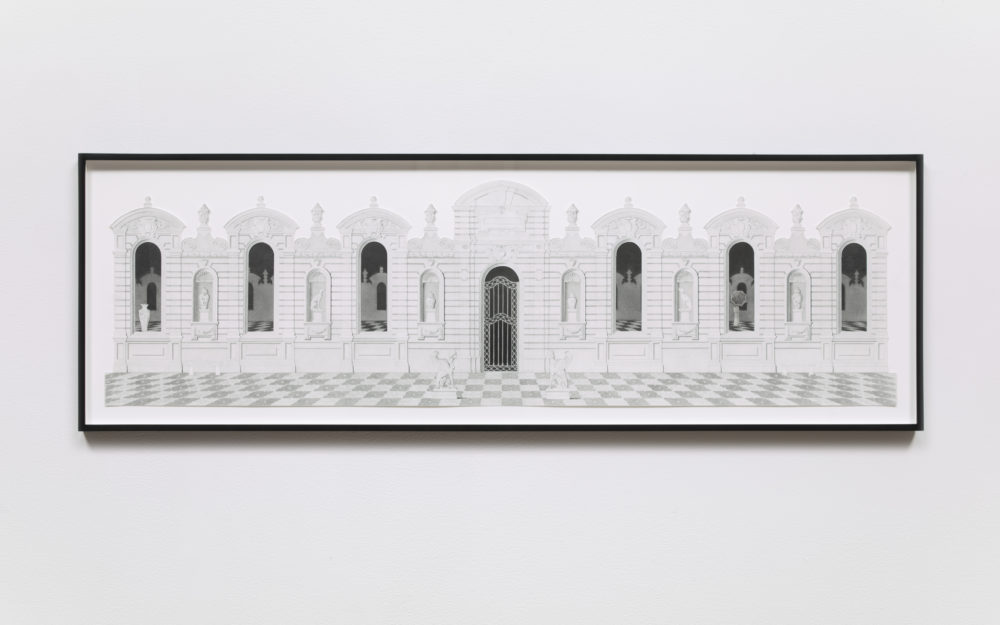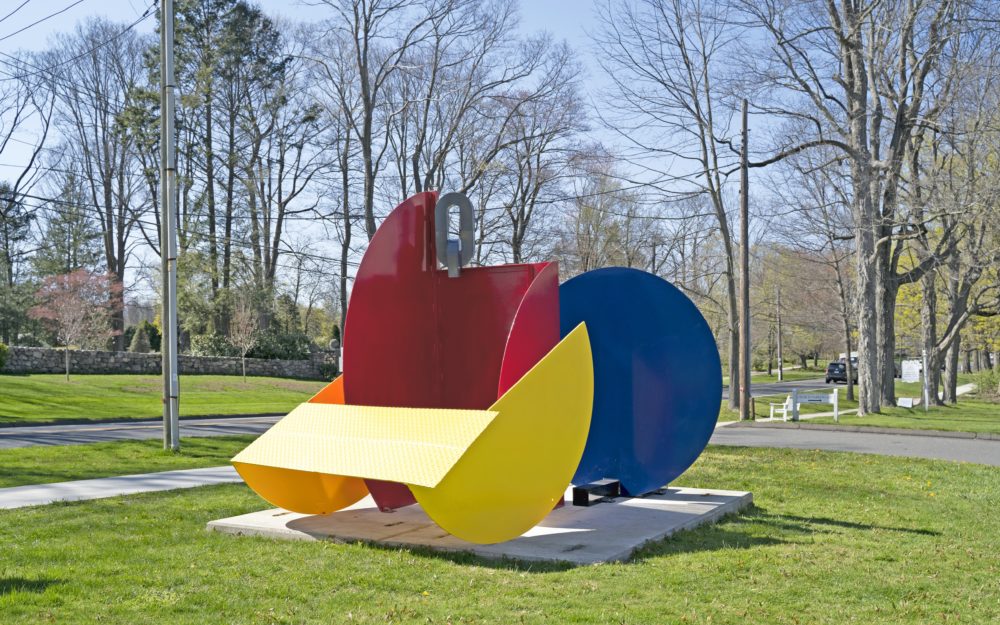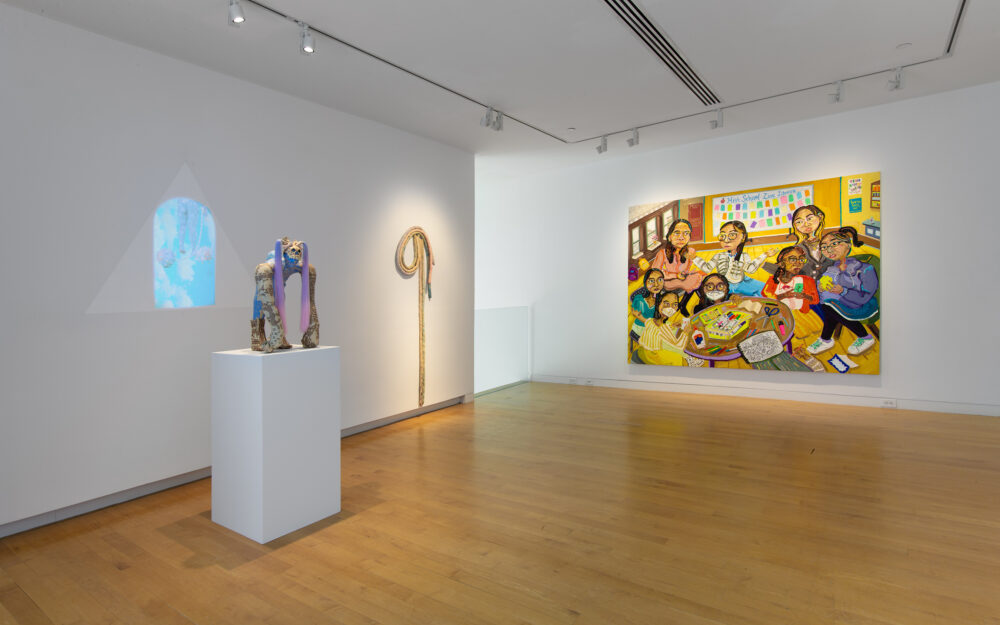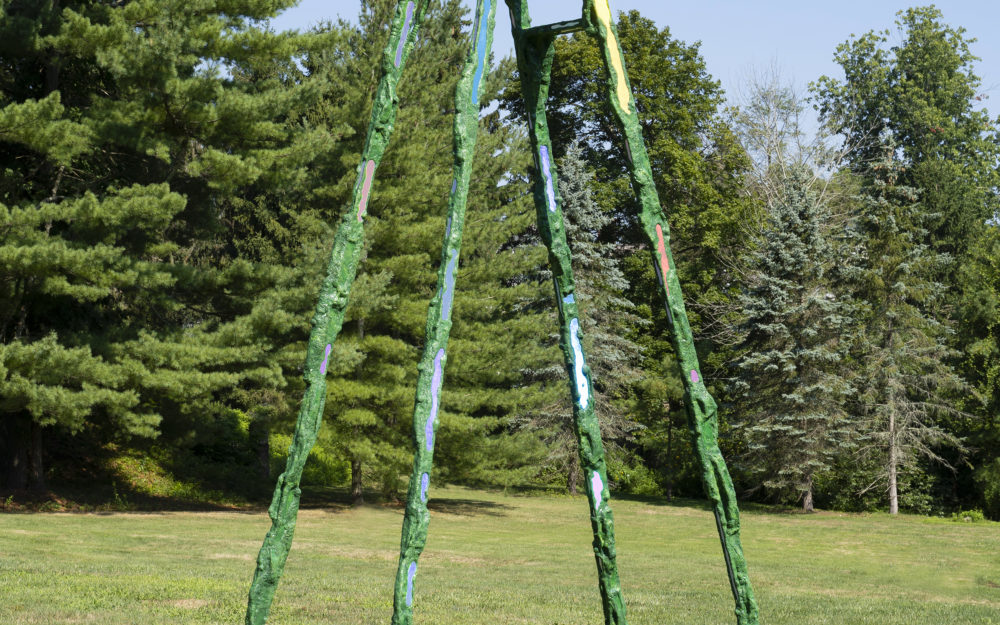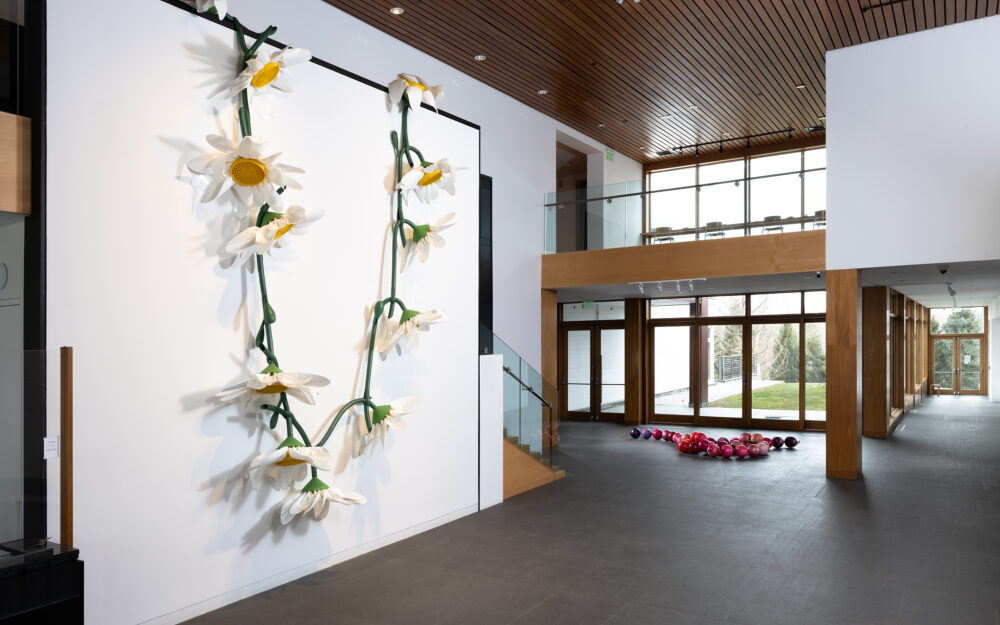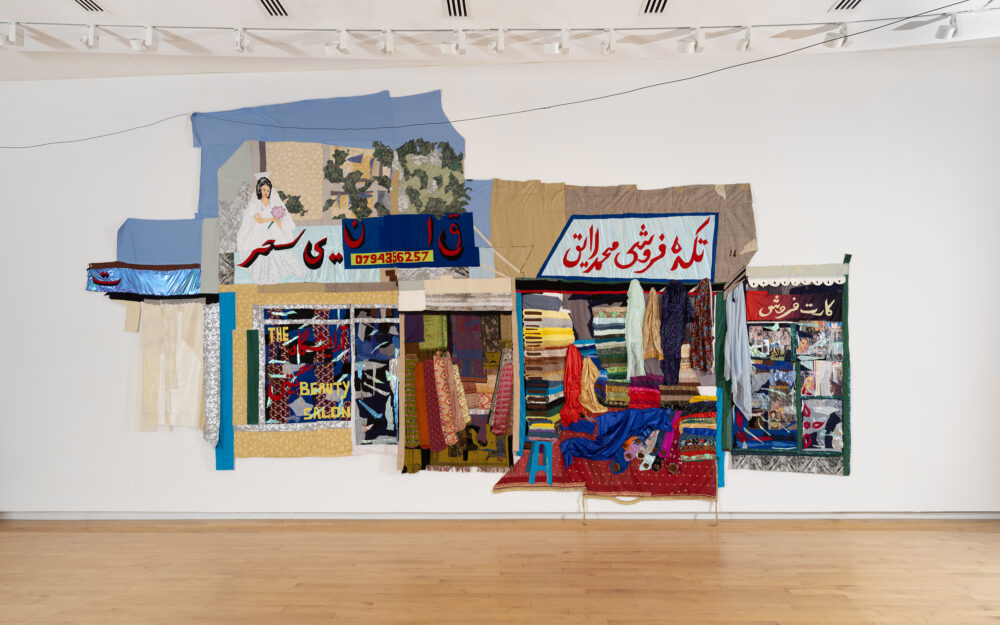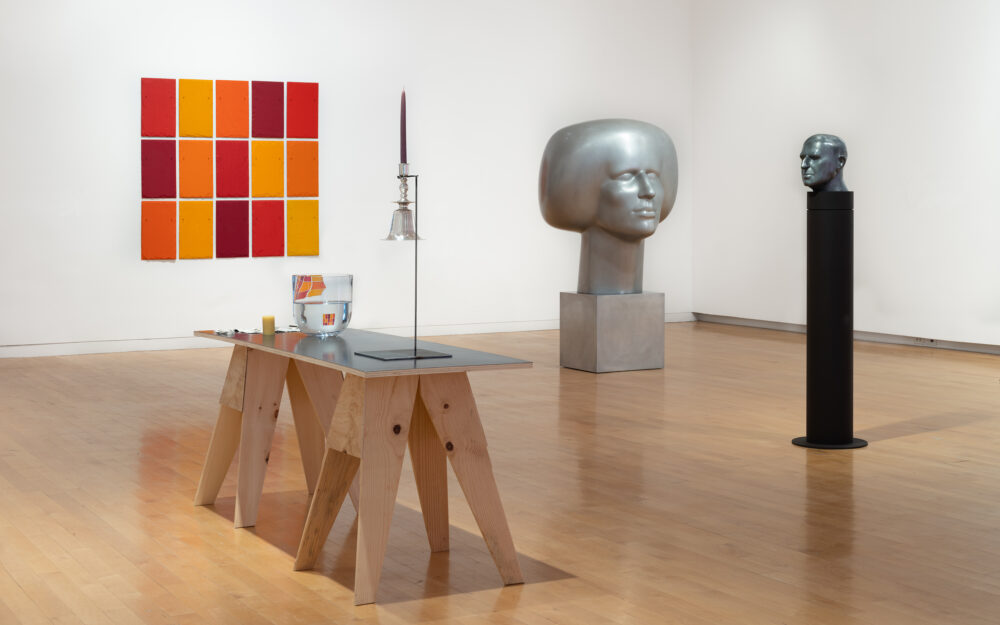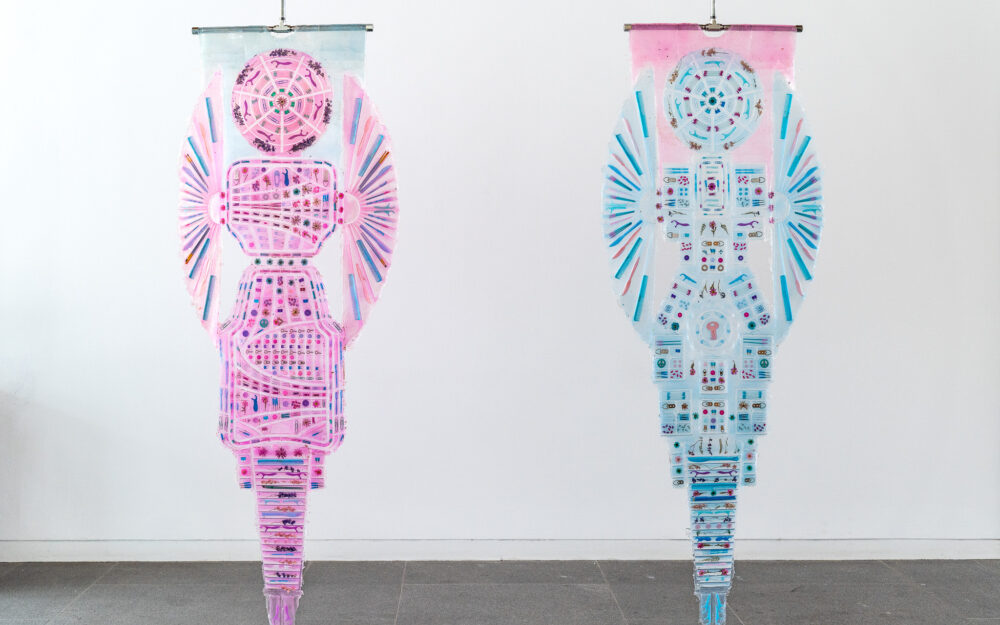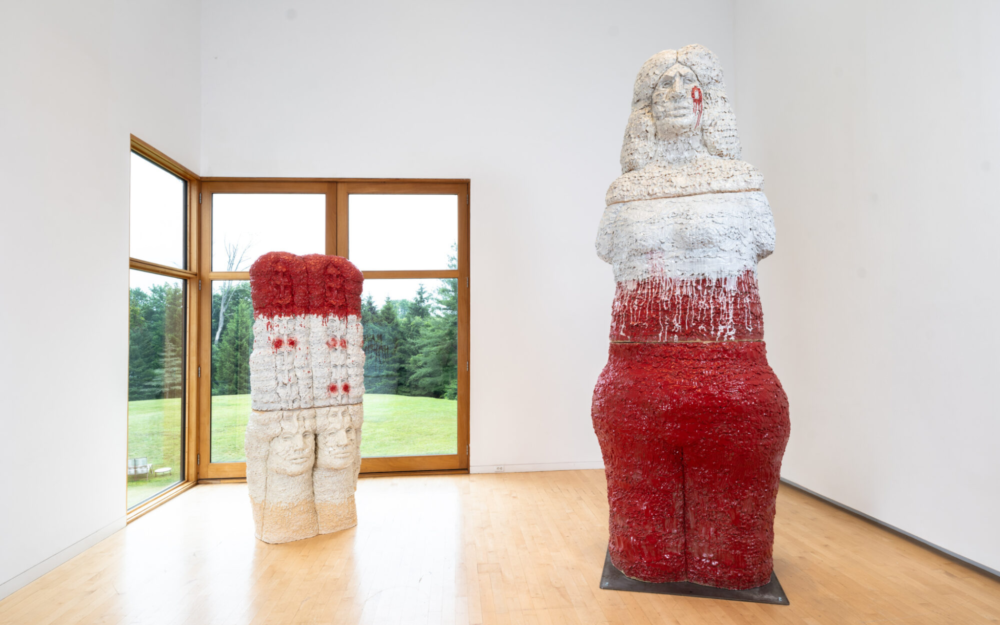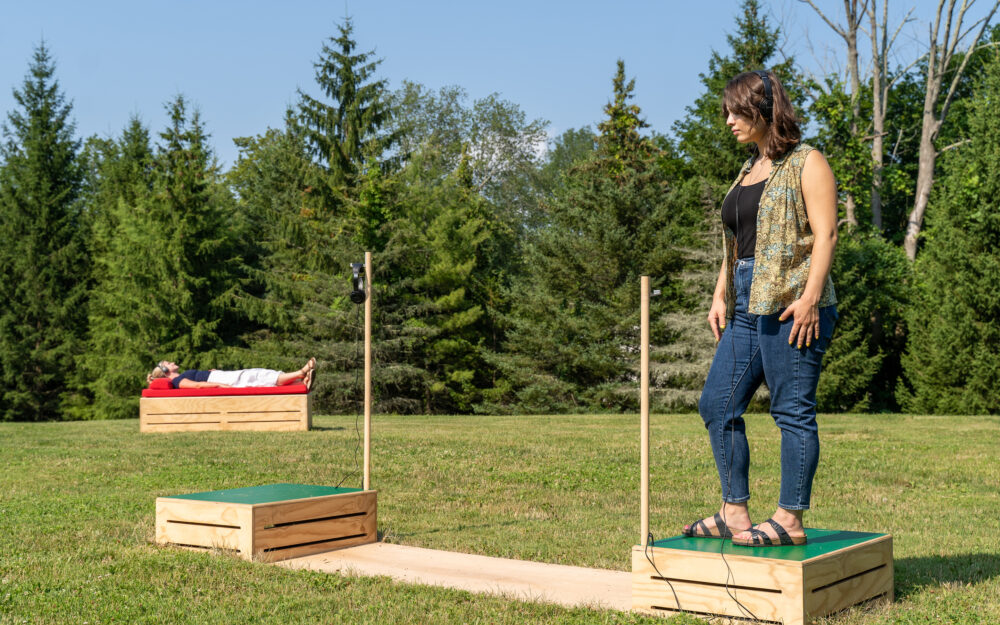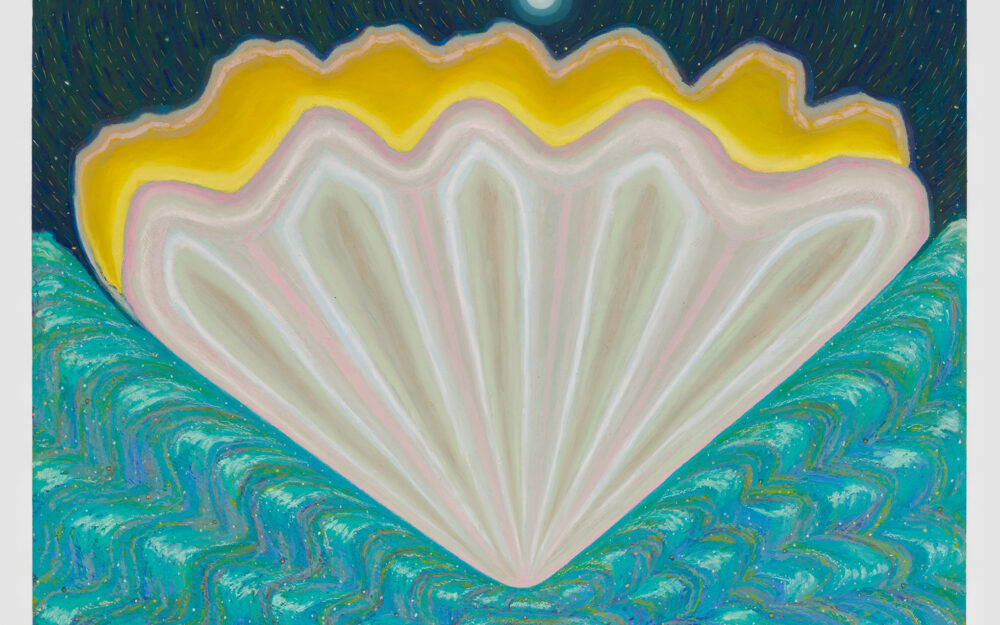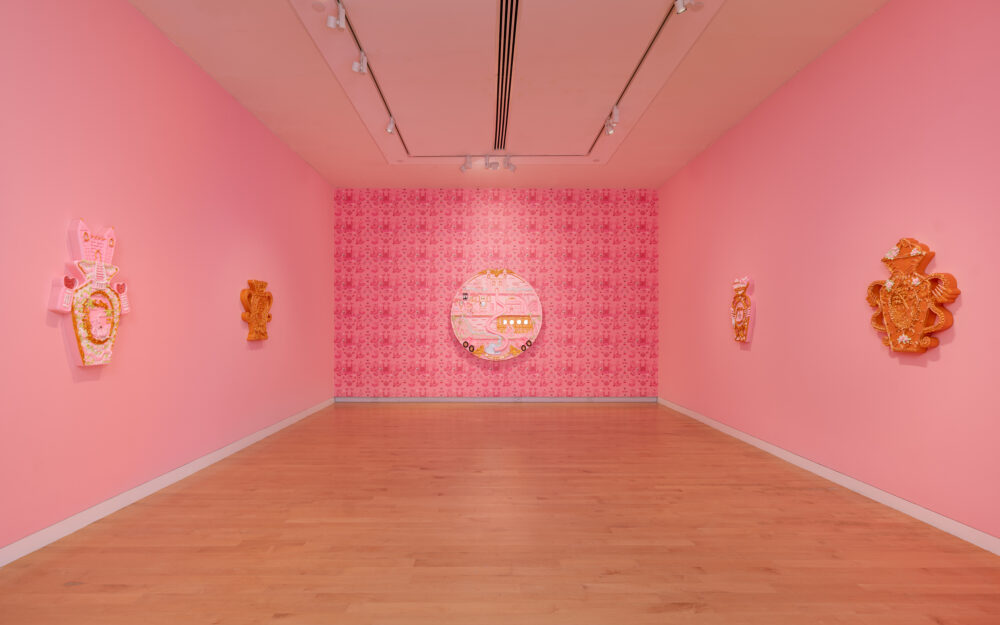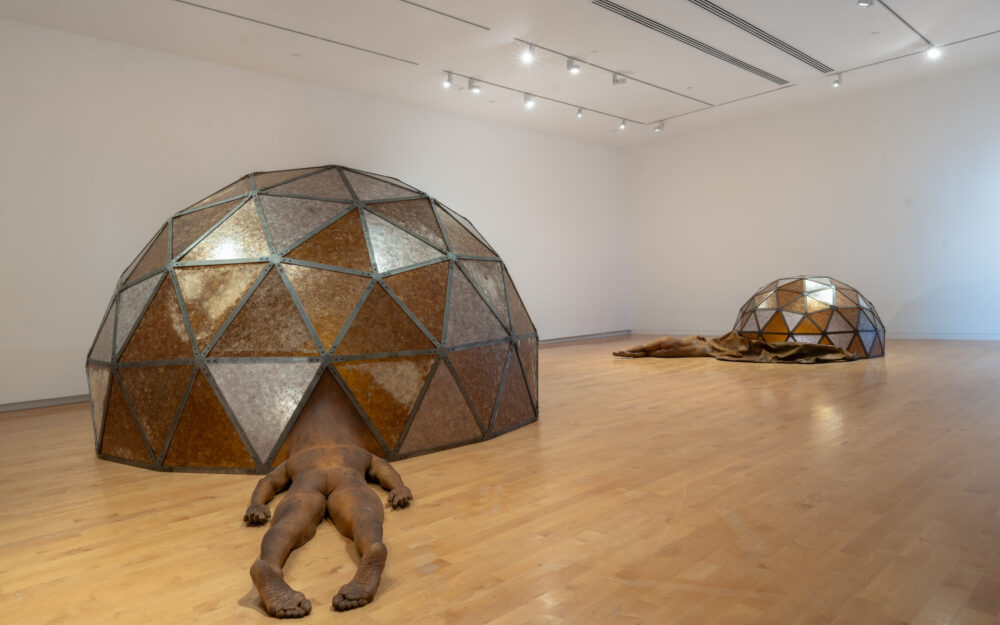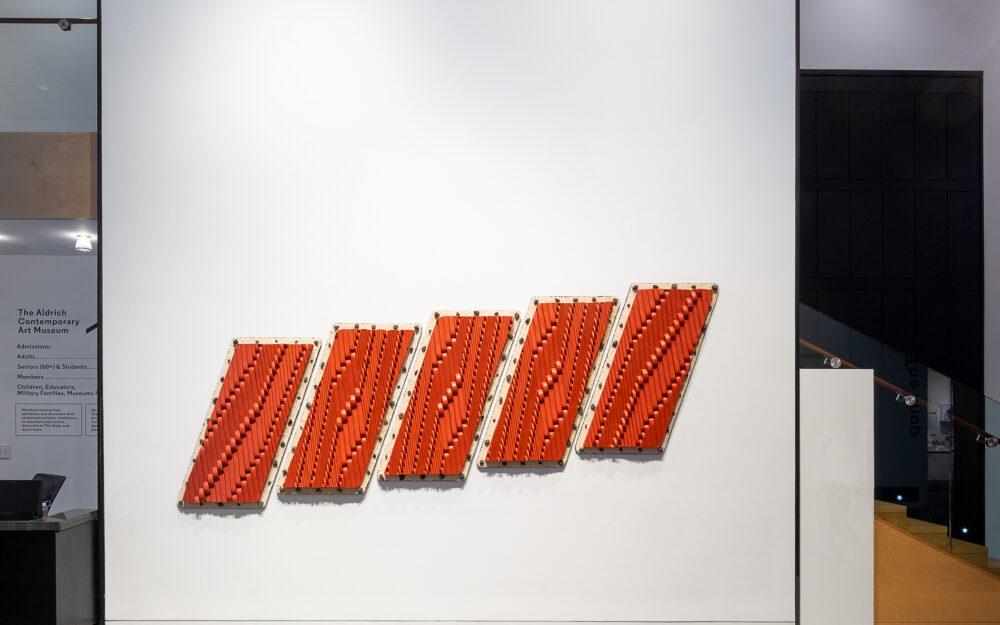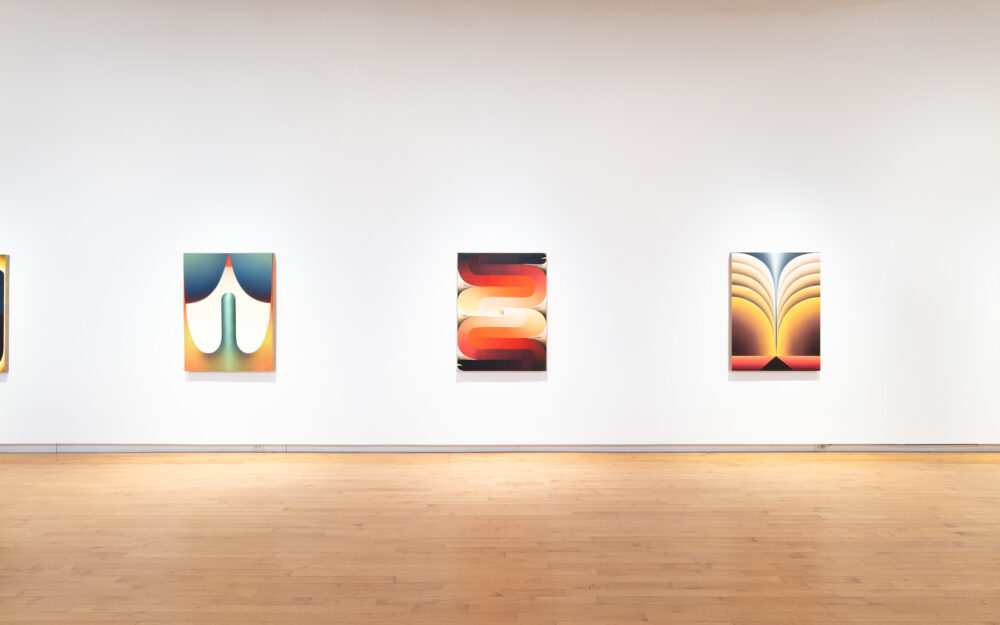- We’re open today from 10 am to 5 pm
- Purchase tickets
- Join mailing list
- Join as a member
- Donate
Past Exhibitions
Frank Stella’s Stars, A Survey
Among the myriad of forms that have appeared in Frank Stella’s work, the star is the most singular, standing out as a stable and immediately identifiable shape in the midst of the complex tangle of abstract, invented forms that the artist has utilized over his long career.
Past exhibitions from the
Tom Friedman: Hazmat Love
The highly inventive and idiosyncratic work of Tom Friedman (b. 1965) often uses everyday materials to explore the nature of object making in our material culture.
Radcliffe Bailey: Vessel III
Vessel III is a cylindrical, twelve-foot high steel chamber that is open to the sky.
Tony Tasset: Deer
For his sculpture Deer (2015), Tasset has taken the common white-tailed deer and blown it into what can only be considered monstrous proportions.
Nari Ward: APOLLO / POLL
For the monumental sculpture APOLLO / POLL (2017) Ward has recreated Harlem’s iconic Apollo Theater sign with a twist: alternately flashing between the word APOLLO and POLL.
Weather Report
Weather Report reveals the sky as a site where the aesthetic, the romantic, the political, the social, and the scientific co-exist and inform one another.
Eva LeWitt: Untitled (Mesh A–J)
The first solo museum exhibition of artist Eva LeWitt (b. 1985). The exhibition, the artist’s largest to date, debuts a significant, new site-specific installation commissioned by The Aldrich.
Zoë Sheehan Saldaña: There Must Be Some Way Out of Here
The work of Zoë Sheehan Saldaña tends to hide in plain sight.
Rudy Shepherd: Somebody's Child
Rudy Shepherd: Somebody’s Child includes twenty-five watercolors chosen from Shepherd’s ongoing Portrait series Rudy Shepherd: Somebody’s Child is curated by Amy Smith-Stewart, Senior Curator.
Genesis Belanger: Through the Eye of a Needle
Through the Eye of a Needle is the first major solo museum exhibition of New York-based artist Genesis Belanger (b. 1978), whose practice spans sculptures and tableaux, primarily composed out of porcelain, stoneware, and upholstery.
Frank Stella's Stars, A Survey | Outdoor Installation
The historical arc of Stella’s use of the star travels from the minimal to the maximal, with the recent star sculptures frequently exhibiting a corruption of the form as well as a wild diversity of materials and fabrication techniques.
Frank Stella’s Stars, A Survey
Among the myriad of forms that have appeared in Frank Stella’s work, the star is the most singular, standing out as a stable and immediately identifiable shape in the midst of the complex tangle of abstract, invented forms that the artist has utilized over his long career.
Twenty Twenty
Twenty Twenty is an exhibition of works on paper rolled out sequentially over the course of five months that presents the work of seven artists who primarily utilize photographic imagery.
Aldrich Care Box
The Aldrich Care Box was a year-long traveling exhibition unbound to a physical space where the Museum commissioned five artists—Ilana Harris-Babou, Clarity Haynes, Athena LaTocha, Curtis Talwst Santiago, and James Allister Sprang—to create a series of objects that examine themes of care, grief, intimacy, and healing through a diverse range of materials, methods, and approaches.
Tim Prentice: After the Mobile
Tim Prentice: After the Mobile is a two-part solo exhibition of one of the most innovative artists whose work has expanded the field of motion in sculpture. Prentice, who turned 90 in 2020, has been a resident of Connecticut since 1975, and After the Mobile marks his first solo museum exhibition in the State since 1999. The exhibition will be presented both in the Museum’s galleries and in its Sculpture Garden, with the indoor exhibition running from March 29 through October 4, 2021 and the outdoor exhibition on view from September 19, 2021 through April 24, 2022.
Aldrich Projects: Clarity Haynes: Collective Transmission
In April 2021, The Aldrich Contemporary Art Museum will inaugurate Aldrich Projects, a single-artist series that spotlights a singular work or a focused body of work by an artist every four months on the Museum’s campus. The first in this series is Clarity Haynes: Collective Transmission. Sited in the Leir Atrium, Haynes debuts two new paintings, Birth Altar, 2020–2021 (2021) and Altar for Femme Joy (2020), from her ongoing Altar series, 2000—. Haynes describes her Altars as queer feminist spaces liberated from patriarchy. She says: “In a time of toxic masculinity and violence, to put forth joyful feminist principles feels radical. To create one’s own archive, altar, cosmology, autonomous space is an act of taking care.”
Lucia Hierro: Marginal Costs
Marginal Costs is the first solo museum exhibition of artist Lucia Hierro. Hierro’s practice, which includes sculpture, digital media, and installation, confronts twenty-first century capitalism through an intersectional lens. Appropriating imagery that ranges from commerce to art history, Hierro’s choices manifest her own multidimensional experience as a Dominican American New Yorker. With a studio methodology steeped in Pop Art, Minimalism, Conceptual Art, and European still life painting, as well as her own biographical circumstance, Hierro’s work surveys power, individuality, and opportunity specific to the communities she orbits.
Hugo McCloud: from where i stand
from where i stand is the first solo Museum exhibition of Hugo McCloud (b. 1980, Palo Alto, CA). McCloud’s work has been defined by a restless experimentation, an ongoing engagement with process, issues surrounding the value of labor, and a concern with disparities in social and racial economics.
Aldrich Projects: Adrienne Elise Tarver: The Sun, the Moon, and the Truth
The Sun, the Moon, and the Truth is the first solo museum presentation of Brooklyn-based artist Adrienne Elise Tarver (b. 1985) and the second series in The Aldrich's newly established Aldrich Projects. Exhibited on the Leir Atrium’s Art Wall, Tarver debuts Manifesting Paradise (2020–ongoing), a suite of twenty-two mixed media works on paper based on the Major Arcana (major mysteries), the foundational card set of the centuries-old tarot deck, alongside Weary As I Can Be (2021).
Tim Prentice: After the Mobile | Outdoor Installation
After the Mobile is a two-part solo exhibition by artist Tim Prentice (b. 1930), known for his innovative work in the field of motion in sculpture. Prentice has been a resident of Connecticut since 1975, and After the Mobile marks his first solo museum exhibition in the state since 1999. The exhibition will feature twenty indoor works, six outdoor works, and a video portrait of the artist, presented both in the Museum’s galleries and Sculpture Garden, with the indoor exhibition on view from March 29 to October 4, 2021, and the outdoor installation on view from September 19, 2021 to April 24, 2022.
Karla Knight: Navigator
Karla Knight's imagery is steeped in science, the occult, early twentieth century abstraction, surrealism and Native American art. And yet, her visual language is purposefully impenetrable—she offers no clues or methods to its decoding. For her, its true meaning must remain unnamed, as it is ultimately inspired by “the mysteries and absurdities of life.” As she asserts, “It’s not about deciphering the work or the language. It’s about living with the unknown.”
Aldrich Projects: Amaryllis DeJesus Moleski: Portal Pieces
Amaryllis DeJesus Moleski: Portal Pieces is the third installment of Aldrich Projects, a single artist series that features a singular work or a focused body of work by an artist every four months on the Museum’s campus. Sited in the Leir Atrium, Amaryllis DeJesus Moleski presents two large-scale works on paper, Graduation Day, 2021, and The Guardians, 2015.
Duane Slick: The Coyote Makes the Sunset Better
Over a career spanning thirty years, painter Duane Slick has consistently pursued a vision to integrate secular Modernist abstraction with the beliefs and traditions of his Native American heritage. Duane Slick: The Coyote Makes the Sunset Better will be the artist’s first solo museum exhibition, bringing together over 90 paintings, prints, photographs, and video, all made within the last five years.
Milano Chow: Prima Facie
This exhibition will mark Milano Chow’s solo institutional debut. Presented in two first floor galleries, Chow will unveil a new body of works on paper spanning two and three dimensions.
Melvin Edwards: Asafokra
Asafokra denotes the artist’s return to painted steel sculpture after working in the medium for roughly a decade. Consisting of three distinct elements, the work includes forms from the artist’s visual vernacular such as a rocker, a disc, and a chain fragment.
52 Artists: A Feminist Milestone
52 Artists: A Feminist Milestone celebrates the fifty-first anniversary of the historic exhibition Twenty Six Contemporary Women Artists, curated by Lucy R. Lippard and presented at The Aldrich Contemporary Art Museum in 1971. 52 Artists will showcase work by the artists included in the original 1971 exhibition, alongside a new roster of twenty-six female identifying or nonbinary emerging artists, tracking the evolution of feminist art practices over the past five decades.
David Shaw: Last Steps
David Shaw’s Last Steps speaks of the challenges we face as a civilization as we try to heal what has been lost. Last Steps will be on view as part of The Aldrich Contemporary Art Museum’s Main Street Sculpture program
Aldrich Box: Hilma's Ghost, Laura Ortman, Ali Kenner Brodsky
Inaugurated in 2021, the Aldrich Box is a year-long traveling exhibition unbound to a physical space. This year’s edition will focus on performance—underscoring the cooperative and interdisciplinary aspects of making art.
Aldrich Projects: Kathleen Ryan: Head and Heart
Kathleen Ryan: Head and Heart is the fourth installment of Aldrich Projects, a single artist series that features a singular work or a focused body of work by an artist every four months on the Museum’s campus. This project brings together two monumental works, Daisy Chain, 2021 and Pearls, 2017, conceived over a five-year span and sited in the Museum’s Leir Atrium.
Hangama Amiri: A Homage to Home
This exhibition is the artist’s solo museum debut and will unveil a new body of work specially made for The Aldrich. It will span the entirety of the Museum’s first floor galleries and will be accompanied by the artist’s first museum publication, with an essay by the exhibition’s curator, Amy Smith-Stewart.
Prima Materia: The Periodic Table in Contemporary Art
Prima Materia is conceived of as a group exhibition that links individual works of art with an element from the periodic table which each work incorporates. Superficially, the exhibition’s foundation is science, but through expansive curatorial choices the project will reveal the material basis for sociological, emotional, political, and even spiritual subject matter.
Aldrich Projects: Amy Brener: Harbingers
Amy Brener: Harbingers is the artist’s first solo museum presentation in the US and the fifth installment of Aldrich Projects, a single artist series that features a singular work or a focused body of work by an artist every four months on the Museum’s campus. The two works on view, Flexi-Shield Harbinger (rose) and Flexi-Shield Harbinger (ice), both 2021, are suspended from the ceiling in the Museum’s Leir Atrium, their larger-than-life forms lightly grazing the floor as they hover side-by-side in front of the lobby’s central wall.
Raven Halfmoon: Flags of Our Mothers
Raven Halfmoon’s practice spans torso-scaled and colossal-sized stoneware sculptures, with some soaring up to nine feet and weighing over eight hundred pounds. With inspirations that orbit centuries from ancient Indigenous pottery to Moai statues to Land Art, Halfmoon interrogates the intersection of tradition, history, gender, and personal experience.
Alex Strada and Tali Keren: Proposal for a 28th Amendment? Is it Possible to Amend an Unequal System
Alex Strada and Tali Keren: Proposal for a 28thAmendment? Is it Possible to Amend an Unequal System (2021-present) will be presented in the Museum’s Sculpture Garden, the first time this project will be installed outdoors on a long-term basis. Strada and Keren’s work will be on view free and open to the public from dawn until dusk at the Museum from July 15 to September 17, 2023.
Ping Zheng: Where Memories of Travels Go
Ping Zheng: Where Memories of Travels Go is the artist's first solo museum presentation in the US. It is the sixth installment of Aldrich Projects, a single artist series that features a singular work or a focused body of work by an artist every four months on the Museum's campus. Installed in the Museum’s Leir Atrium, this presentation debuts six new paintings on paper.
Yvette Mayorga: Dreaming of You
Spanning painting, sculpture, installation, and video, Yvette Mayorga’s work flaunts a maximalist aesthetic rooted in personal narrative and familial histories to examine the Mexican American or Latinx experience in the United States. Mimicking the confectionary labors performed by her mother when she worked as a baker in a department store in the 1970s after immigrating to the US, Mayorga uses bakery-grade piping bags to thickly apply her signature bubblegum pink acrylics to varying sized canvases.
Chiffon Thomas: The Cavernous
This exhibition will be the artist’s solo museum debut. Spanning embroidery, collage, sculpture, drawing, and installation, Chiffon Thomas examines the ruptures that exist where race, gender expression, and biography interconnect.
Amanda Martínez: Canta y no llores
Amanda Martínez will present three sculptures in the Leir Atrium inspired by earth building techniques indigenous to the arid ecoregions that traverse the post-colonial nations of The United States and Mexico.
Loie Hollowell: Space Between, A Survey of Ten Years
This exhibition is Loie Hollowell’s first museum survey and first museum presentation on the East Coast. It will include paintings and works on paper made over a decade, tracking the development of her visual language; a lexicon that bridges abstraction with figuration, autobiography with art history, and biology with mysticism.
Layo Bright: Dawn and Dusk
Dawn and Dusk is Layo Bright’s first solo museum exhibition featuring new and borrowed works in glass and pottery made between 2020 and 2024. The show brings together several ongoing series tracking Bright’s synchronized jumps from figuration to abstraction. Working in the round, on the wall, and in relief, Bright’s practice centers narratives of ancestry, feminism, mass migration, and the African diaspora. She cites her matrilineal heritage, the Nigerian Ife Heads, and West African textiles, as well as contemporary artists Simone Leigh, Kara Walker, Wangechi Mutu, Fred Wilson, and Alison Saar as her inspirations.
Elizabeth Englander: Eminem Buddhism, Volume 3
Nutcrackers, toys, outgrown children’s furniture, and other discarded wooden tchotchkes are the material basis of Elizabeth Englander’s figurative sculptures of gods, goddesses, and saints from the pantheons of Jainism, Hinduism, and Buddhism.
Esther Ruiz: Uncharted
Esther Ruiz’s first solo museum presentation on the East Coast debuts new sculptures including her largest and first freestanding Beacon sculpture to date.
Aldrich Video Series
Aldrich Video Series is a sequence of three solo presentations of video art. Each artist exemplifies a different approach to telling stories. Their distinct practices provide insights into the diverse methods at work in contemporary video art including improvisation, animation, and archival research.
Miles Huston: Overshoot
The artist’s first museum presentation debuts all new work
